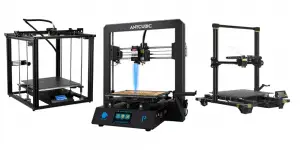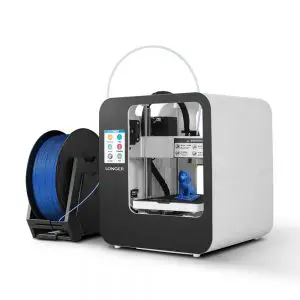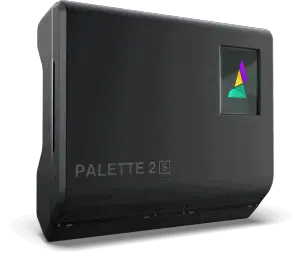If you’re in a hurry and just want to know what the best UV light for curing DLP/SLA resin prints is, then we recommend the FastToBuy UV Resin Curing Light as the best one.
The advancement of 3D printing means an upswing in the technology used during the process. The same occurred when paper printing became a household convenience because it brought along photo printing along for the ride. The increase of photocuring as a 3D printing process brings users the opportunity to make another choice regarding the post-build curing process. So how is someone supposed to choose the best UV light for curing DLP and SLA resin prints?
In This Article We Will Review The Following UV Lights for Curing DLP/SLP Resin Prints:




Is Post-curing UV resin necessary?
Since 3D printing with photopolymer resin is a long enough process on its own, it can be tempting to skip the post-curing part of the build. That would be a mistake leaving the build tacky and weak enough to fail completely. It’s similar to taking a pie out of the oven and not letting it cool down; it doesn’t have time to set the way it’s supposed to. The additional curing time endures a build materializes the was its chemical properties are supposed to along with increasing the strength and durability of the finished product.
What kind of light should be used for photocuring UV resins?
3D printing and its consumables can quickly turn into a costly experience. A way to avoid this is by purchasing the correct equipment from the start. Using natural sunlight, a cheap black light bulb or a UV nail salon lamp can be inexpensive alternatives. However, using these methods run the risk of shortchanging the build and not allowing the chemical properties to reach their prime condition, especially when casting biomedical supplies. The best UV light will be able to achieve the best results for your build, but you have to be specific when identifying the properties of your project and the resin being used.
How much time is necessary to cure a UV resin 3D print?
Curing time for standard resins can range from 10 to 30 minutes depending on the color and size of the build. Engineering-grade resins and resins with biomedical properties can take up to 60 minutes or longer to make it safe for use. It’s essential to research the proper curing times for medical supplies, casts, and moldings to make sure it maintains health and safety requirements.
Common Issues Found During Post-Curing
- If a build shatters or breaks too easily, you may have cured it for too long. Check the shelf life of the resin too. If it’s old or hasn’t been stored properly, builds will fail before it even gets to the post-curing process.
- Curing at a temperature that’s too high, like 75℃ in a curing chamber, can also cause the build to fail from the exothermic reaction within the resin. Try sticking to the recommended time and temperature settings designed for the resin being used.
- Removing the supports of a build can be an issue after post-curing. When a build is finished, removing it from the build plate can be a delicate process. After it’s removed from the plate, but before it’s rinsed, use a pair of snips to get as flush to the build as possible to remove the supports. If you wait until after the curing process, the supports can become brittle and tear out pieces of the build leaving dents and divots behind.
Tip to try: Some users have reported exceptional results by submerging builds in water for additional curing under a UV light source. There’s less oxygen in the water, making the surface of the build stronger and smoother once finished.
Best UV Lights to Cure 3D Printing Resins
Skophy 3D Printer UV Resin Curing Light
Important Technical Specifications
| Wavelength: | 405 nm |
| Light body size: | 115 mm x 85 mm x 90 mm (4.52 in x 3.34 in x 3.54 in) |
| Number of Lights: | 6 LED Lights in a 3 x 2 matrix |
Pros
- There is an aftersale service team and technical support available to troubleshoot any issues that may come up
- The light is projected evenly and with an intensity which helps to speed up the curing process.
- The lamp is easily installed into resin curing stations and is great for other DIY projects
- It uses the same 405 nm wavelength as most photocuring 3D printers
- It’s an inexpensive option that gets the job done
Cons
- Moving the build around to get ample lighting since its trajectory is a small area can cause inconsistent curing
- The prints have to be smaller and really close to the lamp to get adequate lighting.
- Some users report the lamp dying way ahead of its 10,000-hour lifespan
- The 6-LED light pattern projects a checkered light source rather than a uniform stream
FastToBuy UV Resin Curing Light
Important Technical Specifications
| Wavelength: | 405 nm |
| Light body size: | 180 mm x 140 mm x 110 mm (7.08 in x 5.51 on x 4.33 in) |
| UV Lights: | LED light array in a 4 x 5 matrix |

Pros
- The low heat generation makes it a safe but powerful light source
- Resins can cure within seconds as long as they’re moved close to the lamp
- The lamp is eco-friendly and doesn’t contain any mercury.
- The lamp lasts longer than traditional UV lamps with an advertised life of 10, 000 hours
- The lamp comes with a warranty lasting one year
- The power switch is located on the wire instead of the lamp
Cons
- The cord is short which may be cumbersome when trying to set up a feasible curing area for builds
- The price is nearly double the average lamp performing similar functions
- The lamp requires some makeshift mounting to cure builds thoroughly
QUANS 50 Watt UV Ultrasound LED Light
Important Technical Specifications
| Wavelength: | 395 nm – 400 nm |
| Light body size: | 285 mm x 155 mm x 275 mm (11.22 in x 6.1 in x 10.82 in) |
| UV Lights: | LED light array in a 6 x 9 matrix |

Pros
- The light area is large enough for bigger prints
- It’s advertised as waterproof which is helpful if there’s a preference to post-curing in water
- The light source is steady and consistent
- The lamp heats up quickly
- There’s an advertised 50,000-hour life span which is longer than most average lamps
Cons
- The lamp doesn’t reach the standard 405 nm wavelength needed for the biomedical and non-standard resin curing process.
- The wire measures a short 4.6 feet which can limit access to the curing space
- The glass isn’t tempered and can be easily broken
- The lamp isn’t best suited for 3D printing with multiple photocuring resins despite its larger body size
FUNGDO UV Resin Curing Light For SLA 3D Printing & DLP 3D Printing
Important Technical Specifications
| Wavelength: | 395 nm – 405 nm |
| Light body size: | 115 mm x 87 mm x 90 mm (4.52 in x 3.42 in x 3.54 in) |
| UV Lights: | Small LED light array in a 3 x 2 matrix |

Pros
- The lamp works well with curing 3D prints
- Builds can cure within seconds as long as they’re in a 5 cm distance of the lamp
- It can be added to custom curing enclosures and boxes to make a station for builds to finish processing
- The wattage output is high for such a small lamp.
- The company offers a solar-powered turntable that can be purchased with the lamp as an accessory
Cons
- The 6-LED light matrix limits the area for curing forcing the builds to be extremely close to the light source
- Instructions can be confusing when using the recommended additional parts and accessories
- Thicker and larger builds take much longer to cure and do so inconsistently.
Conclusion
When searching for the best UV lights for curing DLP and SLA resin prints, light output, price, and life of the lamp come into play along with the wavelength and lamp size. All things considered, the FastToBuy UV Resin Curing Light seems like the best option with its large lamp area and 405 nm wavelength. Lamps like this can be added to enclosures and boxes for users to make a customized curing station. There won’t be a need to ruin the build by setting it outside in natural sunlight which leaves it tacky and messy to handle.
To get the best use out of the lamp and ensure your builds take full advantage of the post-curing process, consider purchasing a solar-powered turntable. The power of the UV light propels the table to turn so your build can be cured consistently and efficiently. Also, when building a customized curing station it may work better by covering the walls with aluminum foil, or any reflective material, to make sure the UV light is cast evenly onto the build as it turns.
As always keep your safety in mind when using chemicals associated with photocuring 3D printing. Wear gloves when handling the builds and protective eyewear to shield your eyes from the UV rays coming off of the lamps. If possible, when constructing a customized curing station, use an ultraviolet acrylic cover to keep the rays exposure outside of the station to a minimum.
Last update on 2025-06-03 / Affiliate links / Images from Amazon Product Advertising API





